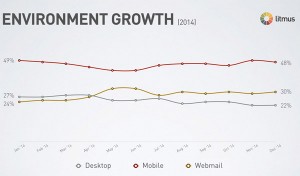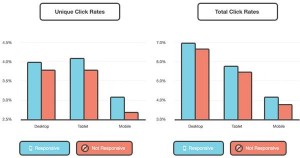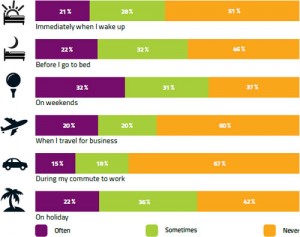We all had been targets of numerous email-marketing campaigns. In digital marketing, email marketing has being increasingly recognised as a cost-effective marketing tool and most effective because of its high response rate (Rettie, 2002) and (Niall, 2000). This initiative has been mostly recognised by businesses due it its ability to provide businesses with communication that permitted relationship building and real-time interaction with consumers (Jackson and DeCormier, 1999) over the past years development of technology has provided marketers channels to deliver email promotion and newsletters and consumers channels to access their emails. But there is one device that is making the most effective change and generating results. MOBILE!!!
In this day and age most people have access to mobile device. With the world population estimate of 7 billion people, 6 billion have access to mobile phones (Wang, 2013). In the UK44% and 61% of households own tablet and smartphone and 56% of them assess Internet through their mobile device (OFCOM 2014). This underlines how central mobile devices is in consumers’ life style.
Over the past 3 years mobile email opens has hit the roof with almost 180% growth (Campaign Monitor, 2015). In the last quarter of 2014 alone, 58% of all opened emails happened on mobile devices, in all, 48% of all emails were read on mobile devices last year (Jordan, 2015).
With all these statistics about ever growing email opened via mobile, has it produce any results? Well, when it comes to responsiveness there was 15% increase unique click on mobile device, higher than other advices such as desktop (Smith 2015). Experian (2013) research on the other hand, also revealed mobile had the second highest unique clicks of 39% behind desktop.
(Unique Clicks– Being able to track when someone visits a website URL. Only one visit is tracked even if the person visits the website multiple times. )
Has this yield results for e-marketers? In 2014, 27% of sales generated in e-commerce came from mobile phones email marketing (Shepherd, 2014). Another interesting factor is the decision making influence it has on consumers. In 2013, 71% of mobile purchases are influenced by email they receive (Adobe, 2013)
This signal very important message to marketers, more emphasis has to be put on the contents of the email and also make sure the content is compatible with consumers mobile device. According to Apsis (2013) survey 46% of their respondents indicated if promotional email is poorly compatible with their mobile device it discourages them to buy something from the retailer. 71% said they will delete it if is not compatible (BlueHornet, 2014).
- When is the right time to send promotional email or newsletter?
We all had unconvinced time to read email and I’m guilty of deleting emails soon as we see it. As a student I read my e-mail in the morning and check one more time before I go bed. Apsis (2013) survey indicated other consumers carry out the same patten. 54% said they read emails on their mobile device before they go to bed whiles 49% said they read their emails first thing in the morning.
Is obvious that mobile devices are central in consumers’ day-to-day activity. Evidences proved above indicates emails open on mobile device are generating results. Therefore is important for e-marketer and retailers’ to pay more attention to their contents and make sure their contents are compatible with consumers’ device.
Reference
Adobe. (2013). Digital Publishing Report: Retail Apps & Buying Habits. Available: <http://www.adobe.com/aboutadobe/pressroom/pdfs/Mobile_Shopping_Retail_App_Usage_on_the_Rise_Infographic.pdf>. (Last accessed 12 April 2015).
BlueHornet. (2015). 2014 Consumer Views of Email Marketing Report.Available: <http://resources.bluehornet.com/resources/form/2014-consumer-views-of-email-marketing-report>. (Last accessed 12 April 2015).
Jackson, A. and DeCormier, R. (1999), “E-mail Survey Response Rates: Targeting Increases Response“, Journal of Marketing Intelligence and Planning, v.17, n.3, p. 135-139.
Jordan,J. (2015). 53% of Emails Opened on Mobile; Outlook Opens Decrease 33%. Available:<https://litmus.com/blog/53-of-emails-opened-on-mobile-outlook-opens-decrease-33>. (Last accessed 12 April 2015).
Niall, J. (2000), The Email Marketing Dialogue, Forrester, Cambridge, M.A.
OFCOM . (2014). The Communications Market 2014 . Available: <http://stakeholders.ofcom.org.uk/market-data-research/market-data/communications-market-reports/cmr14/>. (Last accessed 12 April 2015).
Rettie, R. (2002). Email Marketing: Success Factors. Available: <http://eprints.kingston.ac.uk/2108/1/paper.html>. (Last accessed 12 April 2015).
Shepherd,K. (2014). Mobile E-Commerce Hits All-Time High: New Custora E-Commerce Pulse Report. Available:<http://blog.custora.com/2014/07/custora-pulse-mobile-report/>.(Last accessed 12 April 2015).
Smith, L. (2014). The Science of Email Clicks: The Impact of Responsive Design & Inbox Testing. Available:<https://litmus.com/blog/the-science-of-email-clicks-the-impact-of-responsive-design-inbox-testing>. (Last accessed 12 April 2015).
Wang, Y. (2015). More People Have Cell Phones Than Toilets, U.N. Study Shows | TIME.com. [online] TIME.com. Available at: http://newsfeed.time.com/2013/03/25/more-people-have-cell-phones-than-toilets-u-n-study-shows/ [Accessed 30 Apr. 2015].



